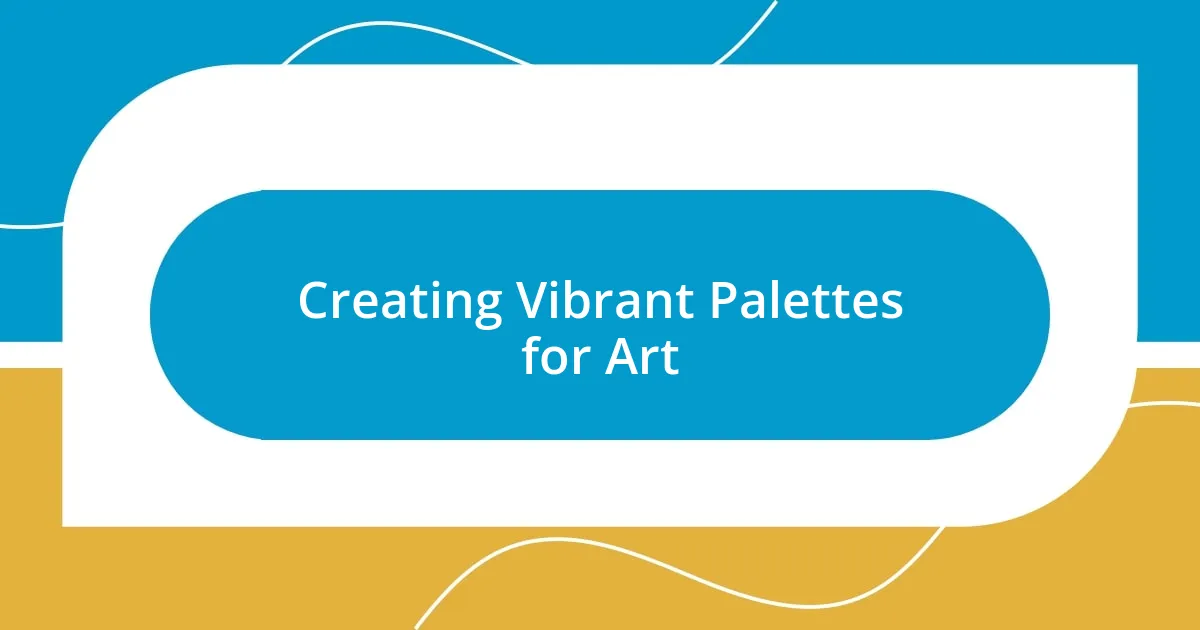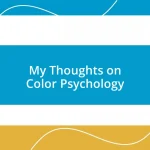Key takeaways:
- Understanding color theory, including the color wheel and harmony, is crucial for effective design and emotional impact.
- Choosing a unifying theme and an anchor color can simplify the palette selection process and enhance the overall composition.
- Exploring different color combinations—complementary, analogous, and triadic—opens up creative possibilities and conveys unique emotional messages.
- Effective use of neutrals can elevate vibrant colors, ensuring a balanced and inviting visual experience.

Understanding Color Theory Basics
Color theory is a fascinating framework that helps us understand how colors interact and influence one another. I still remember the first time I experimented with complementary colors in my designs. The vibrant contrast really opened my eyes to how a little color pairing could evoke strong emotions and create visual harmony.
Understanding the color wheel, which is divided into primary, secondary, and tertiary colors, is essential. Have you ever noticed how certain combinations can either uplift your mood or create a sense of calm? For instance, when I paired a sunny yellow with a deep blue in one of my projects, it not only felt energizing but also brought a sense of balance that made the whole piece sing.
When exploring color harmony, I often lean towards analogous colors—those that sit next to each other on the wheel. There’s something deeply satisfying about how these colors blend seamlessly, like a gentle gradient on a peaceful sunset. Have you tried this approach? I remember a collage I made using shades of green and blue; it felt refreshing and organic, wrapping the viewer in a comforting embrace of nature.

Choosing Colors for Your Palette
Choosing colors for your palette can feel a bit overwhelming at first, especially with so many possibilities out there. I distinctively remember my first attempt at curating a color palette; it was like standing in front of a canvas, unsure of where to start. I found that selecting a unifying theme made a significant difference. Whether you want to convey warmth, tranquility, or vibrancy, defining that emotion helps narrow down your choices and provides a clear direction.
One of my favorite techniques is to start with a standout color that resonates with me and then build around it. In one project, I chose a rich turquoise as my anchor color, and the rest of the palette fell into place seamlessly. It was as if the other colors were waiting in the wings to complement the vibrant star of the show. When I added coral, soft gray, and a hint of gold, the whole piece came together beautifully, creating a lively yet sophisticated vibe.
Don’t shy away from experimenting with shades and tones. For example, when I was working on my living room decor, I explored deeper hues of blue and green to evoke a calm environment. Mixing in lighter shades really balanced the mood. The key here is to ensure that every hue sings in harmony, inviting those who experience your work to feel something special.
| Color Selection Approach | Personal Anecdote |
|---|---|
| Unifying Theme | I defined my palette’s emotion, which guided my choices. |
| Anchor Color | A rich turquoise became the focal point, leading to an effortless palette. |
| Experimenting with Shades | Deeper hues of blue and green transformed my living space into a calm oasis. |

Exploring Different Color Combinations
Exploring color combinations opens up a world of creativity and expression. When I first delved into the realm of bold colors, I remember feeling like a child in a candy store, excited by the sheer number of options. I often experiment with triadic color schemes, which involve using three colors that are equally spaced on the color wheel. This approach can create striking contrasts that energize any design. For example, I once paired a vibrant red, a fresh yellow, and a deep blue for a community art project, and the reaction was overwhelmingly positive.
- Color Schemes to Explore:
- Complementary: Opposite colors on the wheel (e.g., orange and blue).
- Analogous: Colors next to each other (e.g., blue, blue-green, and green).
- Triadic: Equally spaced colors (e.g., red, yellow, and blue).
One of my most memorable experiences with color was during a friend’s wedding where I played a role in the decorations. We decided to use a palette of lavender, peach, and mint green. The way those colors interacted was nothing short of magical, evoking emotions of joy and tranquility simultaneously. I realized that exploring different combinations is not just about aesthetics; it’s about the stories and feelings that they convey. For instance, while opting for complementary colors can stimulate visual interest, the gentleness of analogous hues may invite a sense of peace—perfect for shared moments like weddings.
- Emotional Reactions to Color Combinations:
- Bold contrasts can create excitement.
- Gentle shades evoke calmness.
- Harmonious palettes invite warmth and connection.

Creating Vibrant Palettes for Art
Creating vibrant palettes for art requires a blend of intuition and technical knowledge. I’ve found that starting with a limited selection of colors often leads to more impactful pieces. Once, during a community mural project, I chose just five bold colors and focused on their interactions. Instead of getting lost in options, I realized that limiting my palette often allowed me to create a stronger visual narrative.
One of my surprising discoveries was the power of layering colors. I remember layering a bright fuchsia over a muted lavender in one of my paintings. The result was electric, transforming the whole ambiance of the piece. It made me think: how often do we overlook the beauty in layering different intensities? The added depth and vibrancy breathed life into my work, inviting viewers to explore the layers that told a story of their own.
Additionally, I love to consider the emotional resonance of each color. When I painted a landscape with a glowing sunset, I opted for warm oranges and soft pinks. It seemed to capture a fleeting moment that made my heart flutter. Have you ever noticed how certain colors can transport you back to a cherished memory? That’s the magic of vibrant palettes. They have the ability to evoke feelings, making art not just about aesthetics, but about emotional connections.

Using Color Palettes in Design
Selecting color palettes in design is like composing a unique piece of music; each hue contributes its own note to the overall harmony. I remember working on a branding project where I drew inspiration from nature. That experience taught me how a palette inspired by fresh greens and deep browns could evoke the essence of sustainability. It’s fascinating how, with just a few well-chosen colors, I could communicate an entire brand philosophy.
Color also plays a pivotal role in guiding the viewer’s emotions and perceptions. I once created an event invitation with a palette of soft blues and vibrant oranges, aiming to generate excitement and serenity at the same time. The feedback was enlightening—people expressed admiration for how the colors made them feel both invited and energized. Isn’t it intriguing how color can be a language of its own, speaking to us even before the words reach our eyes?
In another project, I experimented with monochromatic schemes, where I focused on varying intensities of a single color. I was amazed at how a simple shift from a deep navy to a soft sky blue could evoke a whole spectrum of emotions, from calmness to introspection. This journey confirmed my belief that the choices we make in color aren’t just aesthetic decisions; they forge connections, tell stories, and elicit reactions that resonate beyond the visual. How often do you consider the storytelling potential of your color choices? It’s something I now ponder with each new project.

Tips for Harmonizing Colors Effectively
To harmonize colors effectively, I find it essential to use the color wheel as my foundation. For instance, when I chose a palette for a cozy café space, I relied on complementary colors—like deep turquoise and warm coral—to create a vibrant yet inviting atmosphere. Have you ever noticed how certain color combinations pull you in? It’s fascinating how the balance of opposites can lead to a visually striking result.
Another approach I’ve embraced is the rule of three, which suggests using three main colors within a design. Once, while designing a series of posters for an art event, I selected mustard yellow, navy blue, and muted gray. That combination not only conveyed energy but also offered enough contrast to grab attention without overwhelming the viewer. It made me wonder: how can we simplify our choices to amplify our message?
As I delve deeper into color harmonization, I’ve grown to appreciate the role of neutrals in my palettes. By integrating soft shades like cream or beige, I was able to give the vibrant colors room to breathe. I remember an instance when I paired lively greens with a gentle off-white in a nature-inspired illustration. The result felt fresh and spacious, almost as if I was inviting viewers to step into the scene. Isn’t it interesting how the right neutral can elevate the vibrancy of your main colors?

Showcasing My Favorite Color Palettes
When I think about my favorite color palettes, one that stands out is a delightful combination of pastel pinks and soft blues. I used this palette for a wedding invitation a couple of years ago, and it was remarkable how the gentle hues set a romantic tone. It made me realize how a delicate color scheme can evoke emotions of love and serenity—don’t you feel the same way when you see those colors together?
Another palette that has won my heart is a bold mix of emerald green, rich gold, and deep burgundy. I applied this combination in a piece of graphic art for a local festival. It instantly brought to life a sense of elegance and richness, almost like stepping into an opulent gala. It’s fascinating how vibrant colors can transform the mood of a project and invite viewers to explore deeper layers of meaning—what do you think this palette communicates?
More recently, I’ve been drawn to earthy tones like terracotta, muted olive, and soft cream for home decor projects. I remember redesigning my living room with this palette, and it created such a warm, inviting atmosphere. It was as if nature itself was welcoming me inside. This experience opened my eyes to how color choices not only reflect personal style but also create spaces that resonate with comfort and tranquility. Have you ever felt an instant connection to a space simply because of its colors?














